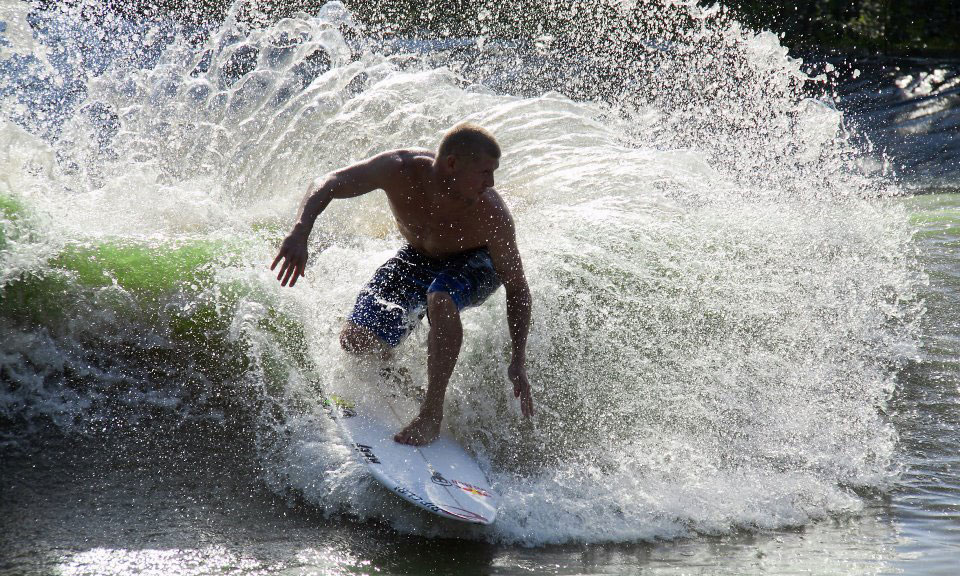
Making Waves: Surfing Groups Bank Sport’s Future on Man-Made Parks
With a little help from man-made technology, surfing industry groups hope that consistent waves and modern technology mean industry growth and an Olympics bid. But not everyone's convinced it's a good thing for the industry.
Surfing associations hope the latest artificial wave technology will help grow the industry and the sport—and maybe help it win a spot in the Olympics. But not everyone is convinced the change is for the better.
Surfing is a popular sport, but there are two inherent challenges to its mass appeal: location and inconsistency.
You can play baseball pretty much anywhere, but you need some big waves to make it worth your while to hop on a surfboard. That generally means being on a coast or an island. And you can’t count on catching the waves that makes surfing so exciting: On any given day they might be perfect—or you might not have any.
But several industry groups are working to solve these challenges by encouraging the spread of surf parks.
Thinking man-made: Surf parks and wave pools have been around for decades, but they’ve improved in recent years. New wave-building technologies, such as American Wave Machines’ SurfStream system, are helping to bring surfing to the masses in locales that are not exactly hotbeds of wave-riding, like New Hampshire and Quebec. (Wave generation tech manufacturer Wavegarden’s demo center in Northern Spain is shown in a video above.) “Mother Nature stipulates that surfing only can occur where waves can be born. When man takes his hand to forming the waves, it unlocks the potential of surfing anywhere. And that is the most powerful thing,” Surf Industry Manufacturers Association (SIMA) President Doug Palladini told the Associated Press in September before the start of the inaugural Surf Park Summit. The meeting in Laguna Beach, California, drew industry leaders, surfers, and investors to discuss how the technology could advance the sport.
Potential for growth: The benefits for the industry could be huge. Approximately half of all independent surfing-supply stores worldwide closed during the recession, the AP reported. But what is now a $6 billion industry, according to SIMA, could experience a new wave of growth if the once-regional sport can unlock itself from the seacoasts. And while the surfing culture has an established niche, the sport itself needs room to grow, argues American Wave Machines President Bruce McFarland. “The industry is doing a good job selling surfing as a lifestyle. It is fun. It influences culture, music, fashion, all that. It is imbedded. But it is hard for anybody who doesn’t live near the ocean to do,” he told Reuters.
The ultimate aspiration: It’s still a half-pipe dream, but industry groups hope that the recent advances in technology could help create the right conditions for surfing to become an Olympic sport—an achievement that has boosted the popularity of its frigid cousin, snowboarding, immensely. (Two words: Shaun White.) “Without man-made waves, there will not be Olympic surfing,” International Surfing Association President Fernando Aguerre told the Associated Press in September. “It’s the ultimate wave-sharing that you can imagine.”
Surfing skeptics abound: But not everyone’s sold on the idea of a wave pool boom. Surfer Jamie Currie argued in a blog post on The Inertia that the advent of man-made waves could damage the sport. “Waves should not be caged so that imbeciles can stick their fingers out and touch something they would not normally have access to,” he wrote. “This will only lead to disaster when they encounter one out in the real world that doesn’t behave as predictably as it did in captivity.” Another surfing blogger, Zac Heisey, shared that view, writing that what artificial-wave supporters “don’t seem to realize is that the ‘inherent variables associated with surfing’ are precisely what make surfing great. For the life of me, I can’t quite understand why everyday surfers are unable to recognize these thinly veiled ‘innovations of progression’ for what they are—further attempts to commercialize surfing.”
Think surfing can make a breakthrough with a little man-made help? Let us know your take in the comments.
Professional surfer Mick Fanning catching a wave at the Wavegarden in Spain. (photo via Wavegarden's Facebook page)





Comments